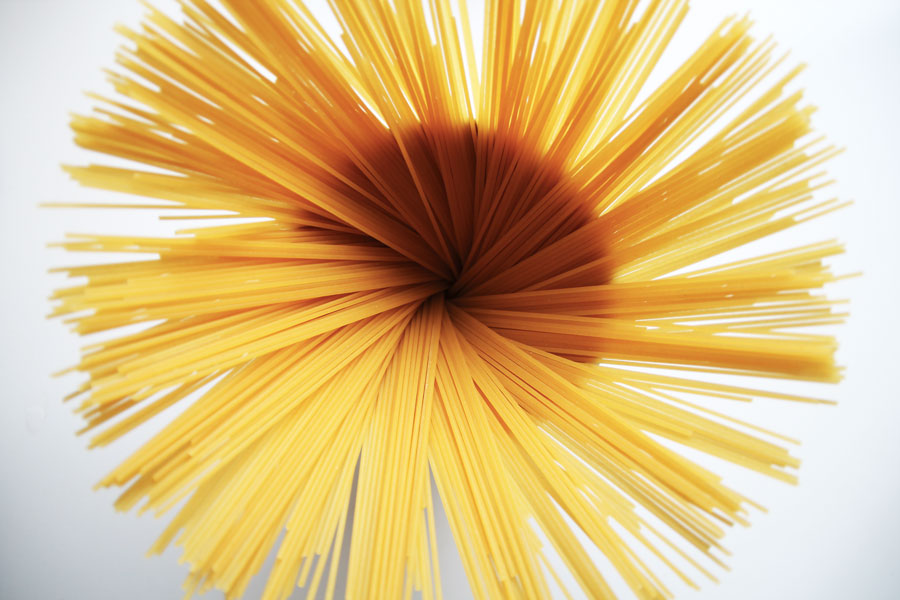Like all good staples pasta is a simple delicious dish to cook and eat. But there is pasta and then there is pasta and then there are Italians. Speak to any enthusiastic Italian (i.e. any) and they will soon be telling you all of the important little ways of how pasta absolutely must be cooked. But the question is are they all true?
In a nutshell the pasta is quite simple – boil the pasta until it is tender and put some sauce on it. Bang done. Delicious! But then of course you can easily over-cook the pasta making it gloopy and soggy. The pasta can stick together in clumps, which remain uncooked in the middle. Getting flavour into your pasta can be an issue too. Whether to salt the water? And the difference between stirring sauce into the pasta or putting it on top? And how to get the pasta to suck up as much sauce as possible – because let’s face it not many of us actually eat pasta for the taste of the pasta? Sauce is king.
Of course there are plenty of theories as to how to cook perfect pasta. There are techniques which claim to help stop the pasta sticking together and ideas in how to get the maximum sauce uptake. There are even theories how to get the perfect consistency of pasta sauce. So let’s run through them and sort fact from fiction and explain why many Italians will happily miss important meetings and stop rush hour traffic to enthusiastically tell you how you should cook your pasta.
Pasta should be cooked to ‘al dente’, Italian for ‘to the bite’. This essentially means that you want to be cooking your pasta so that it still has a little bite to it. It should most certainly not be cooked until it is soggy like baby food. Cooking pasta to al dente is much the same theory as steaming veggies. You want them still to have a little crunch to them on the inside. But you do want them to be cooked. Bear in mind that the pasta will keep cooking after it has been removed from the heat and drained of water. This is because it will still have residual heat in it.
One simple way to get around pasta that keeps cooking once it is removed from the heat is to run it under cold water. This will however, make the pasta cold (and in requirement of re-heating if you want to eat it warm) and will wash away the starchiness around the outside. Most Italian cooks will look in horror if you use this method, because the starch on the outside of the pasta is often used to thicken the sauce when added and make it more creamy. The heat of the pasta will also help it suck up more sauce, because the starch molecules will be opened up while they are heated. Which is why you should not drain the pasta too much (i.e. leave a little starchy water clinging to it) and add it to the pan of sauce and stir it in. This will achieve maximum sauce uptake and the best sauce consistency which will allow it to cling to the pasta.
This brings us to a contentious point. What to add to the boiling water before you add the uncooked pasta? Salt is very important. This is a great opportunity to get some extra flavour into the pasta. Not adding salt will leave the pasta tasting bland and will actually require you to add far more salt to your sauce which in the long run will have the end result of you eating more salt. Also remember that you are salting the water, most of which will be drained away, so don’t be shy to add plenty. The water should taste of similar to saltiness to sea water.
The second, and contentious, ingredient that is often been discussed is the addition of oil. Some say that the oil will coat the pasta and stop it sticking together. This is not true. The secret to stop your pasta sticking together is to add plenty of boiling water to your pot – at least twice the amount of water as pasta, three times if possible! This is not to say that the oil method does not have merit, however. By adding oil to your boiling pot of pasta you will change the surface tension on top of the water which will inhibit the water from frothing up and boiling over the sides of the pot. You will have to add a fair amount of oil for this effect and to be honest you are better off just using a large pot that is filled less that 2/3 full of pasta and water. If you don’t have a large enough pot then oil may be a good option.
One last tip for cooking spaghetti, linguine, fettuccine etc is to fan them out in the pot (see top picture). Fan the noodles out in your hand before adding them to the pot. This will significantly aid the noodles in stopping them to stick together. The technique is fairly simple. Hold the noodles in both hands and twist in opposite directions, much like giving someone a Chinese burn on their arm (just softly mind you – you don’t want to snap them). This will cause them to fan out. Hold the noodles so they are vertical and drop them into a pot of salted boiling water.
There you have it. Now there is no excuse to putting up with sub standard pasta. Your taste buds will thank you and you will have a great topic of conversation should you ever travel to Italy. If someone starts talking about perspective drawing and Michelangelo you can always steer the conversation to safer waters (no pun intended) by asking their perspective (pun intended) on the merits of adding oil to a pot of boiling pasta.


